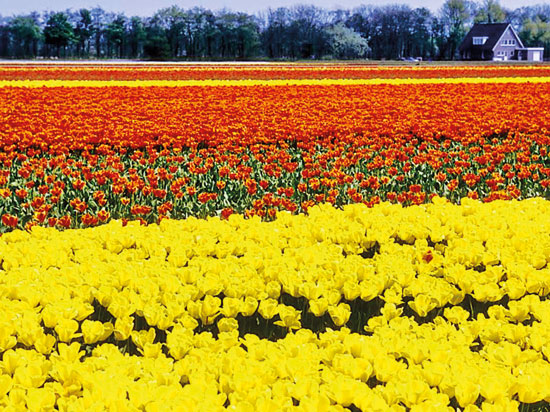Tiny land with towering yield
View(s):One of the most notable gatherings took place at the residence of the Dutch Ambassador to Sri Lanka, Bonnie Horbach, who graciously hosted a seminar and invited a distinguished group of participants from the diplomatic corps, international think tanks, and global business organisations.

Farm of flowers in the Netherlands
From the Netherlands
While my intent is not to delve into the specifics of the book or the seminars themselves, I must emphasise that transformative growth is essential for Sri Lanka—now more than ever. It represents a vital strategy to steer the country away from recurring crises and to lift millions out of crisis-driven poverty.
What I wish to highlight today is a compelling and related insight that emerged during the seminar—from the Netherlands. It raised an intriguing question: how far can a small economy advance in agricultural development?
Sri Lanka, as a small and developing economy, has much to gain by examining the extraordinary agricultural transformation of the Netherlands. Despite its size, the Dutch economy has achieved remarkable success in agriculture, driven by innovation, efficiency, and policy foresight.
Yet, comparisons with the Netherlands are rarely made—perhaps due to its status as an advanced nation in the European Union, while Sri Lanka continues to grapple with the challenges of development. Nonetheless, the Dutch example presents an inspiring model that could help unlock new horizons for Sri Lanka’s agricultural sector, if only we dare to look beyond conventional boundaries.
Large country syndrome
 Whenever the topic of agricultural development arises, our instinctive focus tends to be on the availability of large arable land for cultivation. We are conditioned to associate agricultural dominance with land-rich nations such as the US, Brazil, Russia, and Australia—countries that boast vast tracts of farmland.
Whenever the topic of agricultural development arises, our instinctive focus tends to be on the availability of large arable land for cultivation. We are conditioned to associate agricultural dominance with land-rich nations such as the US, Brazil, Russia, and Australia—countries that boast vast tracts of farmland.
For context, the average farm size is approximately 466 acres in the US, 202 acres in Brazil, 370 acres in Russia, and a staggering 7,000 acres in Australia. These countries also host extraordinarily large farms—sometimes exceeding 100,000 acres, and in rare cases, even reaching into the millions.
When confronted with such figures, it is natural to assume that smaller countries are unlikely to thrive in global agriculture unless their rural populations—especially poor farmers—are protected and supported. In fact, the reality in Sri Lanka is that most farmers are smallholders, and over 80 per cent of the nation’s poor continues to remain concentrated in rural agriculture.
This perception stems from the widely held belief that the advantages of economies of scale in agriculture favour large countries and extensive farms. Larger agricultural operations tend to yield higher output at lower average costs, leading to more competitive pricing.
When domestic markets are saturated, these surplus outputs must cater to the global market, where they benefit from lower production costs and stronger price competitiveness—effectively allowing the countries to dominate international agriculture trade. In such a landscape, small-scale agriculture faces formidable structural challenges that cannot easily be mitigated by conventional policy approaches alone.
Small country miracle
The Netherlands is a small country—smaller than Sri Lanka, in fact. With a land area of just 33,600 square km, it covers nearly half the territory of Sri Lanka. Its population stands at around 18 million, compared to Sri Lanka’s 22 million. Even in terms of agricultural land, the Netherlands has only 18,000 square km, whereas Sri Lanka has approximately 28,000 square km.
Despite these indicators of “smallness,” the Netherlands has emerged as the world’s “second-largest agricultural exporter” after the US. In terms of export value, the Netherlands has surpassed all other land-rich nations including Brazil, Russia, and Australia—defying conventional expectations.
In 2023, Dutch agricultural exports reached an impressive US$136 billion, while the US led with $196 billion. Key Dutch exports include flowers, dairy products, vegetables, and processed foods. Meanwhile, the US mainly exports soybeans, corn, wheat, beef, and cotton. Brazil, now the third-largest agricultural exporter, held the second position until it was overtaken by the Netherlands. Brazil’s exports total $130 billion, driven by products such as coffee, soybeans, beef, and sugar. Although Russia and Australia possess expansive agricultural lands, their export values remain relatively modest.
Hard for protectionists
The Netherlands is not only the second largest agricultural exporter in the world, but also the largest agricultural importer in the European Union. That is a hard fact for us, the protectionists in Sri Lanka to admit. We think that agriculture sector must be protected from imports to raise domestic production. Therefore, we don’t allow agricultural imports to come easily.
For our major agricultural imports, there is a licence requirement, while it is a policy decision that the Cabinet of Ministers must decide! Accordingly, we have made it difficult for the Sri Lankan people to eat good food at cheap price – double punch to the country’s poor!
The Netherlands imports $ 110 billion worth agricultural produce, which is about 80 per cent of the country’s agricultural export value. The main imports include wheat, soybeans, oilseeds, fruits, vegetables, dairy products, and coffee.
Someone will have a question: How could they allow importing the same products that they export? Where is protection for domestic agriculture?
Thriving and surviving
Like Sri Lanka and many other nations, the Netherlands too provides agricultural subsidies and incentives as permitted under the European Union’s Common Agricultural Policy (CAP). These include income support for farmers, sustainability incentives to promote environmentally friendly practices, and productivity support to enhance efficiency and innovation in the sector.
EU member states also apply relatively higher tariffs on agricultural imports in accordance with World Trade Organization (WTO) guidelines. Unlike Sri Lanka, however, the EU does not employ para-tariffs. In addition to tariffs, the EU enforces rigorous health, safety, and environmental standards, meaning that on agricultural exports to the region must comply with a comprehensive set of regulations.
Sri Lanka’s approach to protecting the agricultural sector involves a combination of tariffs, para-tariffs, and non-tariff barriers (NTBs) to shield local producers from competitive imports. The government also provides a wide range of subsidies, such as free or reduced-cost agricultural inputs—including seeds, plants, fertilisers, and irrigation water—alongside price ceilings, extension services, and institutional support mechanisms.
Despite all these protective and supportive measures, the outcomes in the two countries are markedly different. In the Netherlands, farming households tend to be part of the country’s high-income demographic and are thriving under a system that combines innovation with strategic policy support. In contrast, Sri Lankan farming communities, many of whom belong to low-income groups, continue to struggle—surviving rather than prospering.
Crux of the matter
Now, the big question is how did the Netherlands manage to climb so high in terms of agriculture development by overcoming the challenge of being a small country? And what lessons that Sri Lanka as a small developing country can learn from that?
One could point out the extra-ordinary agriculture technology in the Netherlands, including mechanisation, automation and even the use of robots. They must also overcome the seasonal variation in climatic conditions against agrculture.
There is a focus not only on intensive agriculture practices (as extensive farming is constrained by limited land), but also on ‘sustainable farming’. This means balancing productivity with environmental concerns, economic viability, and social responsibility.
One important feature of the Dutch farming that we have ignored throughout is the importance of the ‘scale of economies’ in agriculture production. According to European Commission’s agriculture and rural development statistics, the average farm size in the Netherlands was 80 acres in the year 2000. After two decades by 2021, the average farm size in the Netherlands had exceeded 100 acres!
With reasonably large average farm size, obviously the Netherlands can accommodate only a small number of farmers out of its labour force – it is less than 2 per cent of the labour force. Accordingly, out of 10 million labour force, there are less than 200,000 farmers employed in about 51,000 farms in the country.
Although it is already clear about the structural problem of Sri Lanka’s agriculture sector, let us look at it closely in the coming week.
(The writer is Emeritus Professor at the University of Colombo and Executive Director of the Centre for Poverty Analysis (CEPA) and can be reached at sirimal@econ.cmb.ac.lk and follow on Twitter @SirimalAshoka).
Hitad.lk has you covered with quality used or brand new cars for sale that are budget friendly yet reliable! Now is the time to sell your old ride for something more attractive to today's modern automotive market demands. Browse through our selection of affordable options now on Hitad.lk before deciding on what will work best for you!


